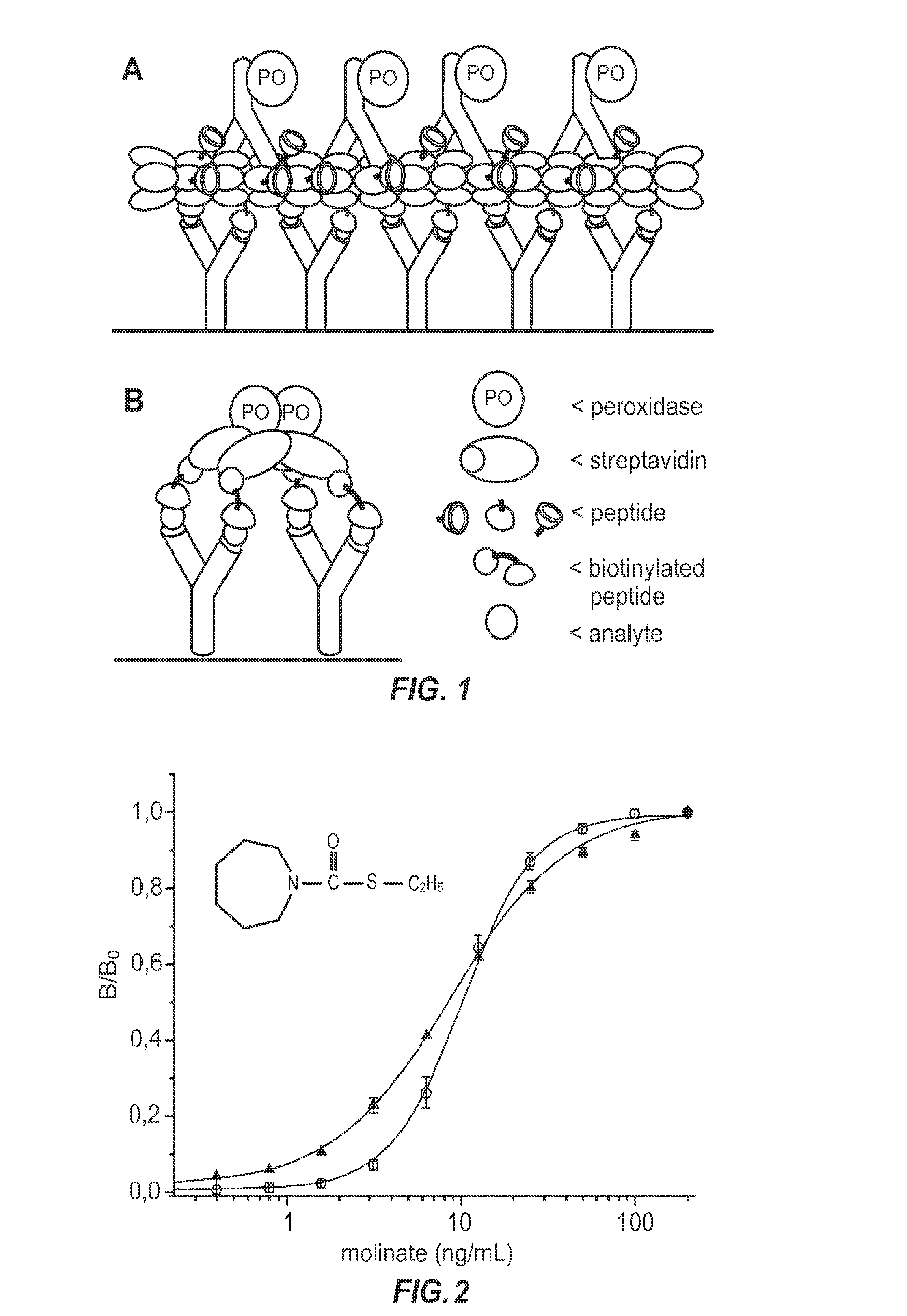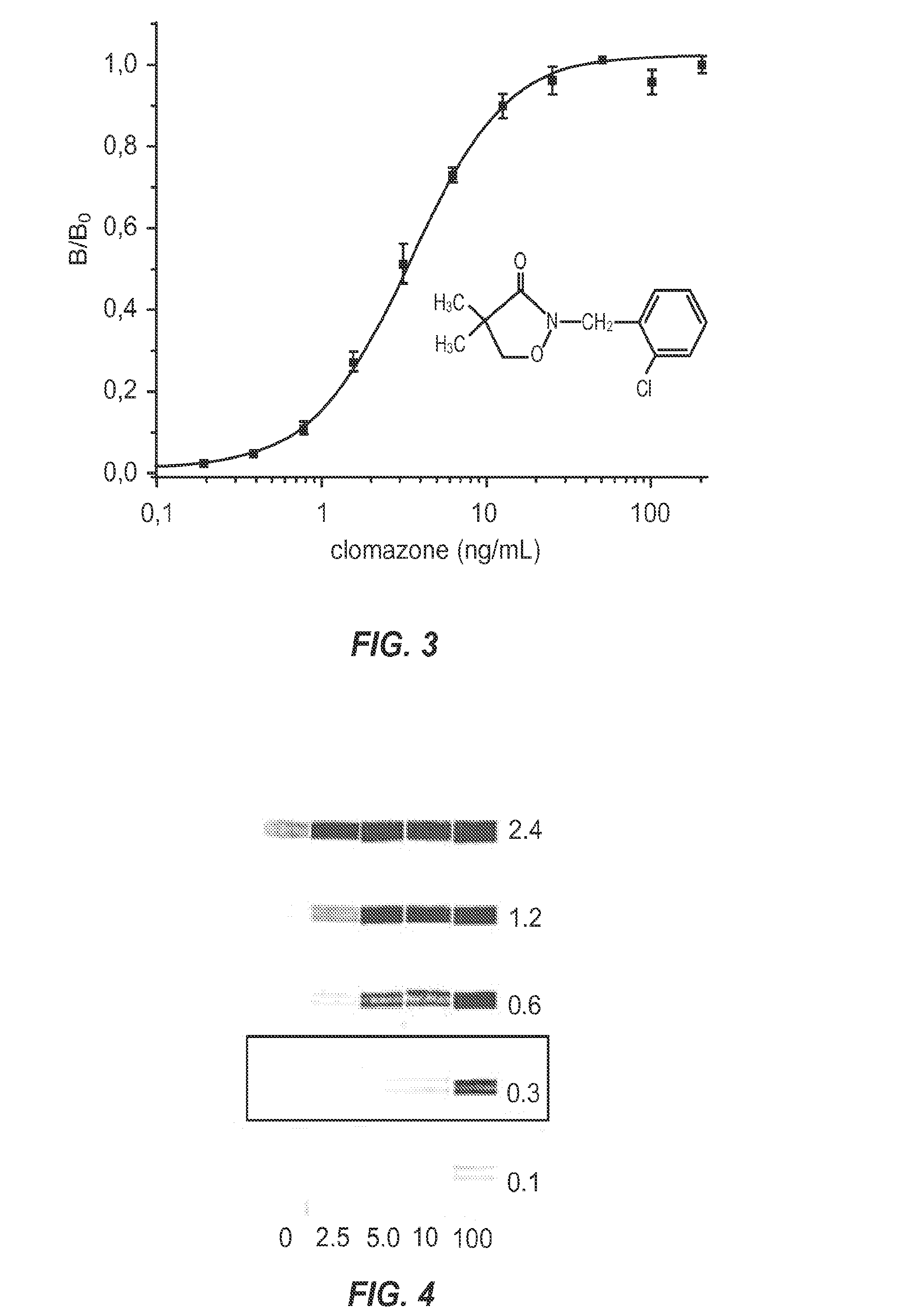Non-competitive immunoassays to detect small molecules using nanopeptamers
- Summary
- Abstract
- Description
- Claims
- Application Information
AI Technical Summary
Benefits of technology
Problems solved by technology
Method used
Image
Examples
example 1
Detection of Small Analytes Using Nanopeptamers in a Noncompetitive Assay
[0110]This example demonstrates that nanopeptamers can detect small analytes in a noncompetitive immunoassay.
[0111]In this example, a nanopeptamer comprising streptavidin was used to develop noncompetitive assays for the analytes molinate and clomazone. Peptides that specifically bind molinate and clomazone were conjugated to biotin, resulting in high affinity binding of the biotinylated peptides to streptavidin. The streptavidin-biotinylated peptide complexes are referred to as nanopeptamers.
[0112]A. Materials and Methods
[0113]Molinate and the thiocarbamate compound standards used in the immunoassays were gifts from Stauffer Chemical Co. Thiobencarb was a gift from Chevron Chemical Co. Development of the monoclonal anti-molinate antibody (MoAb 14D7) and anti-clomazone antibody (MoAb 5.6) has been described in detail previously (Carlomagno, M.; Matho, C.; Cantou, G.; Sanborn, J. R.; Last, J. A.; Hammock, B. D.;...
example 2
Devices for Detecting Small Analytes
[0133]This example demonstrates that the methods of the invention can be performed using an easy to read device, and that the device can detect small analytes at lower concentrations than a device used to perform a competitive assay directed to the same target analyte.
[0134]A. Dip Stick Devices
[0135]MoAb 14D7 was printed on nitrocellulose at different densities (0.1, 0.3, 0.6, 1.2, and 2.4 ng / cm2). The nitrocellulose was cut into strips and contacted with SPO-pA and various concentrations of molinate (0, 2.5, 5.0, 10.0, and 100 ng / ml). The peroxidase activity was developed with diaminobenzidine.
[0136]As shown in FIG. 4, the pA-SPO nanopeptamer was capable of detecting immune complexes comprising molinate in a dipstick assay device. At high antibody coating densities of antibody MoAb 14D7, the residual cross-reactivity of the nanopeptamer with the unliganded antibody produced a visible signal. However, at lower coating densities, the background rap...
example 3
Recombinant Nanopeptamers
[0151]This example demonstrates that nanopeptamers comprising recombinant fusion proteins can detect the small analytes molinate and clomazone in noncompetitive immunoassays.
[0152]The embodiment described in the above example makes use of nanopeptamers having biotinylated peptides that bind streptavidin and / or avidin. In this example, nanopeptamers were constructed using recombinant fusion proteins that comprise an oligomeric core protein and peptides that specifically bind the target analyte. The use of fusion proteins simplifies the assay and avoids the cost of synthesizing biotinylated peptides. This example describes two different recombinant nanopeptamer platforms, a streptavidin-peptide and a verotoxin-peptide recombinant nanopeptamer.
[0153]A. Streptavidin-Peptide Recombinant Nanopeptamers
[0154]In this example, the monomeric subunit of core streptavidin is produced in E. coli as a recombinant chimeric protein with the anti-immunocomplex peptide fused t...
PUM
 Login to view more
Login to view more Abstract
Description
Claims
Application Information
 Login to view more
Login to view more - R&D Engineer
- R&D Manager
- IP Professional
- Industry Leading Data Capabilities
- Powerful AI technology
- Patent DNA Extraction
Browse by: Latest US Patents, China's latest patents, Technical Efficacy Thesaurus, Application Domain, Technology Topic.
© 2024 PatSnap. All rights reserved.Legal|Privacy policy|Modern Slavery Act Transparency Statement|Sitemap



